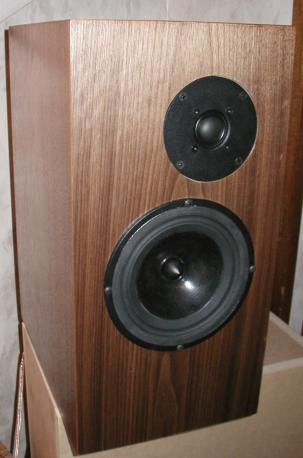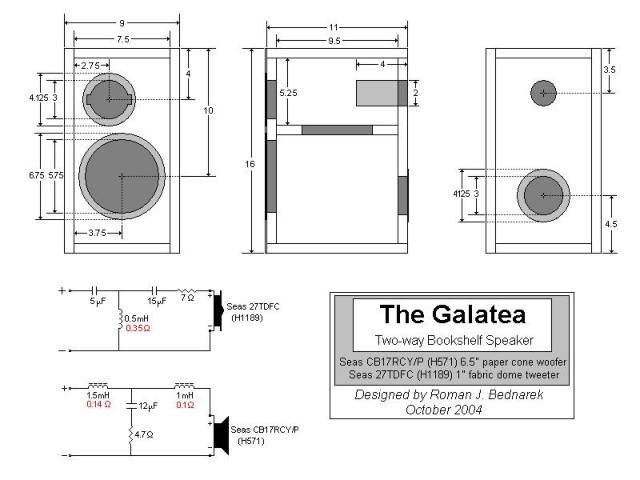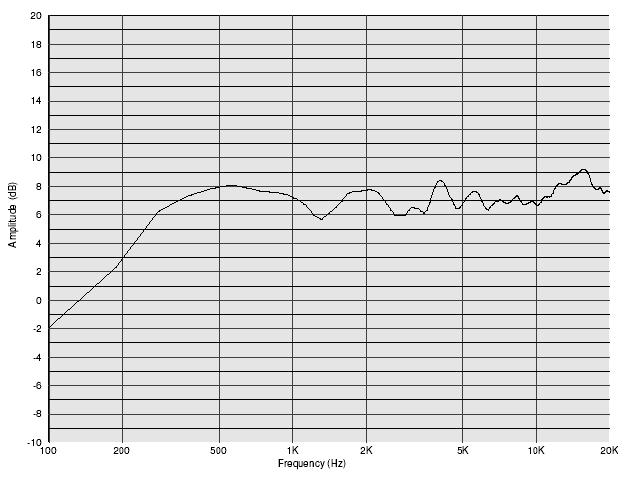


IntroductionThe Galatea is a medium sized bookshelf speaker design using the Seas CB17RCY/P(H571) 6.5" woofer and the Seas 27TDFC(H1189) fabric dome tweeter. The Galatea uses the same woofer as the Proteus jr. and the tweeter is also very similar as well. Some say that the 27TDFC that is used in the Galatea is a drop-in replacement for the 27TFFC that is used in the Proteus jr. The Galatea would probably work well as a surround speaker in conjunction with the Proteus jrs. as front channel speakers. Since Proteus is one of Neptune's moons, I named these speakers after one of Neptune's smaller moons. The Galatea design probably offers the best performance to price ratio of any of my designs because they only cost around $200 a pair and they sound very good.DriversSeas 27TDFC(H1189) 27mm High Definition precoated fabric dome tweeter with a wide, soft polymer surround. The dome and surround materials give high consistency and excellent stability against variations in air humidity. The voice coil is wound on an aluminum voice coil former with adequate ventilating holes to eliminate noise from internal air flow. The voice coil is immersed in low viscosity magnetic fluid, for high power handling capacity and simplified crossover design. A stiff and stable rear chamber with optimal acoustic damping allows 27TDC to be used with moderately low crossover frequencies. The chassis is precision moulded from glass fibre reinforced plastic, and its front design offers optimum radiation conditions.Seas CB17RCY/P (H571) CB17RCY/P is a 6.5" High Fidelity woofer with an injection moulded metal chassis. The high quality paper cone and high loss rubber surround give a smooth, accurate response which extends to 4000 Hz. The special treatment of the cone produces a well behaved roll off characteristic, which simplifies crossover design. The treatment of the cone also reduces potential resonance problems. A bullet shaped phase plug increases the power handling capacity, reduces compression due to temperature variations in the voice coil and eliminates problems with resonances which would occur in the volume between the dust cap and the pole piece. A high temperature voice coil wound on an aluminium voice coil former gives a high power handling capacity. The extra large magnet provides extra sensitivity and low Q. Cabinet DesignThe Galatea cabinet is around 16 liters in volume with a port tuning of around 51Hz which theoretically gives them an f3 in the low 50s. I used a piece of 1/8" masonite on the front baffle with a hole cut out for the tweeter in order to flush mount the tweeter. I designed the cabinet without a grill and offset the tweeter to reduce diffraction effects. The cabinets should be built as mirrored pairs with the tweeter towards the outside edge. The prototype design shown in the pictures uses the cabinet intended for the Extremis design with a higher port tuning. The Galatea cabinet is shorter and less deep relative to the Extremis cabinet that was used during the design phase. The Galatea cabinet is better suited to the H571 and will increase the power handling capabilities but may have a slightly higher f3.
Crossover DesignDuring the design phase of the Galatea I experimented with several different crossover topologies including 2nd order Linkwitz-Riley, 4th order Linkwitz-Riley, and Acoustic Reality series crossover designs. I chose a crossover frequency of 2kHz for all three of these designs. Initially I intended to use the AR series crossover because it only used four components, provided a reasonbly flat response and had a tighter overall sound. However after doing some comparisons I concluded that the AR series crossover was a bit too warm in the midrange and lacked the detail that some of the other topologies had. I tried to adjust the component values to compensate for this warm midrange sound but since there are only four components and they are interdependant I found it difficult to improve the sound so I decided to concentrate my efforts on the 2nd and 4th order Linkwitz-Riley designs.I was able to get a nice, balanced response from the 2nd order Linkwitz-Riley filter but the optimal listening axis was too low, closer to the woofer height than the tweeter height. The 4th order Linkwitz-Riley filter on the other hand had a listening axis at the tweeter height. So when I initially began comparing the sounds of these two filter designs I was listening on the tweeter axis and the 4th order LR filter sounded stronger at and above the crossover frequency due to the misaligned phase response of the 2nd order filter at that height. So in order to make a better comparison between these two designs I discovered a circuit (ladder delay circuit) that can be used to delay the output of the tweeter and raise the 2nd order filter's optimal listening axis to match that of the 4th order design. The only problem with this circuit is that it requires two inductors and two capacitors per speaker which increases the total crossover part count significantly. Now that both filters were tuned to be in phase on the tweeter's axis I adjusted both crossovers to produce nearly identical frequency responses while trying to keep the response as flat as possible. I was able to tune the crossovers within 0.5 dB of each other which is pretty close especially considering that across most of the response they were within 0.2 dB of each other. Now that I had the phase alignment and frequency responses matched between the 2nd order Linkwitz-Riley and 4th order Linkwitz-Riley filters it was time to compare the sound between the two designs. Surprisingly the two filters sounded almost identical in almost every aspect. The only noticeable difference between the two filters was that the 4th order design had more presence in the upper midrange region just above the crossover point. This contradicted the measurements slightly because the 2nd order design actually measured just a bit stronger in this 2kH-6kHz region. After doing a bit of research I've concluded that differences in off-axis and power responses between the two topologies is what is causing this added presence in the 4th order filter. The fourth order filter has a slight peak in it's power response around 4kHz relative to the 2nd order filter and there is less of an off-axis dip in the response in this region as you move above and below the ideal listening axis for the 4th order filter. What really surprised me about this comparison was that I couldn't hear any difference between the imaging and soundstaging characteristics between these two designs. I was previously under the impression that lower order crossovers had more focused imaging and a more realistic soundstage but now I'm not so sure about this issue. After all of the listening and comparing I decided to choose the 4th order Linkwitz-Riley filter for this project. I didn't feel that there was any benifit in using the 2nd order design based on sound quality differences and the 4th order design uses a lot fewer parts when you consider the parts needed for the ladder delay circuit (however, if you were to recess the tweeter or slant the baffle back you wouldn't need this extra circuit.) I actually liked the added presence in the crossover region and the fact that the response didn't dip as badly off-axis with the 4th order filter. Furthermore, the fact that the 2nd order filter didn't seem to improve the imaging and soundstage relative to the 4th order design gave me no reason to choose the 2nd order filter. The 4th order Linkwitz-Riley crossover filter is shown in the schematic above and only uses 8 components per speaker. I went with laminated steel core inductors in the woofer filter for both the 1.5 mH and 1.0 mH inductors (mostly because that's what I had laying around, but partly because it improves the bass efficiency due to the low DC resistance.) You could probably use heavy gauge (14 or 16 gauge) air core inductors in this circuit but the overall sound may get a bit brighter because the response below 1kHz will drop just slightly. PerformanceBelow is a plot of the gated frequency response of the Galatea design measured at a distance of 2 meters away. The gated measurement removes any room reflection influences at the expense of lower frequency measurement resolution/accuracy. The measurement should be reliable from about 400Hz and up. Overall the frequency response is pretty flat except for one peak around 15kHz which is present in the tweeter's response. Even with the peak, the frequency response is better than +/-2dB from 400Hz to 20kHz. Efficiency is around 85dB at 1W/1meter which is slightly higher than the Calypso design and is just about the same as the Asterion design.
Due to the simplicity of the crossover and the relatively low cost of the drivers this design offers high performance at a low cost. A pair of Galatea should run just over $200 and are the least expensive of all of the designs I've completed so far. Surprisingly they cost slightly less than the smaller Calypso design and offer better performance. So, unless you are trying to conserve space and are limited to a smaller cabinet design, I would say that the Galatea are a better choice than the Calypso in performance and value. Speaker Workshop Project FileThe Speaker Workshop project file for this design is now available for download: Galatea LR4 vs LR2.swd. This project file includes both a 2nd order Linkwitz-Riley version and a 4th order Linkwitz-Riley version. There are measurements of the both crossovers implemented in the cabinets for both designs at several microphone heights. There are gated measurements for the drivers at different listening axes (TA stands for "Tweeter Axis" and WA stands for "Woofer Axis"). There's also a pair of crossover network simulations based on measurements taken on axis with the tweeter. The file is about 1.4 MB so be patient if you have a slower connection. |
